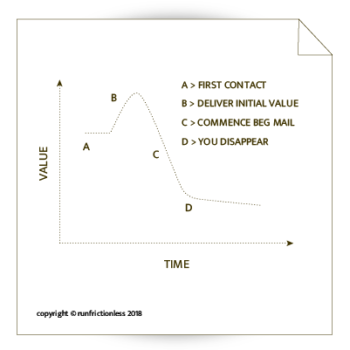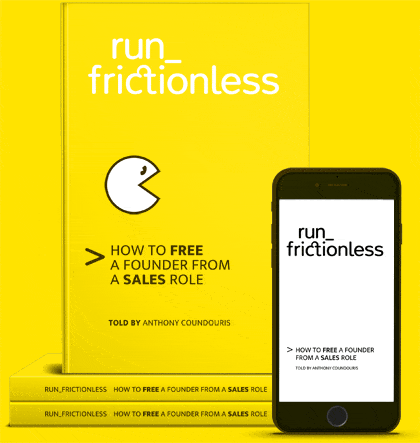
Five unforgettable beg mail scripts
>
Five unforgettable beg mail scripts
In a previous article titled Stop Writing Beg Mail and Start Writing Value Mail, I highlighted the dangers of beg mail. If you remain unconvinced of why your sales organization should send value mail instead, read on. We have prepared five awesome scripts to beg your way to your next sale.
If you have nothing useful to say to your customer, try beg mail
Take the 14-day beg mail challenge
The definition of beg mail is where the salesforce call or messages a customer and beg for a decision. The first of its kind, you could call a ‘follow-up’ email. Every email like it thereafter is beg mail.
Below I have prepared 5 beg mail scripts you can send out over a 14-day period. If you are an advocate of beg mail, feel free to cut and paste this script in your next sales mail. Check out my analysis of why each beg mail fails.
Beg mail day 1
ANALYSIS
Tom is insensitive to how busy or distracted Sally was that week. His reason for contacting Sally begins with an idle curiosity about her cat’s health. Sally is aware this is a cover for beg mail.
Tom’s call-to-action is weak. He suggests getting ‘started’ because he is ‘available’. Whether Tom has spare capacity to handle Sally’s project is irrelevant to Sally’s buying decision. At this point, Sally is evaluating several suppliers and is not thinking about a start date.
Beg mail day 8
ANALYSIS
When Tom says ‘I haven’t heard from you…’, what he really means is ‘It has been a week since I ate my last meal’. Tom is short of sales that week and Sally is one of many customers he is spamming with beg mail.
Tom serves up another weak call-to-action. This time he offers Sally an opportunity to speak over the phone. Sally will never get on a call unless there is a compelling reason in her favor. Sally is conscious if she joins a call with Tom, that Tom is likely to abuse her time by begging for the business.
If this email does a terrible job of setting an appointment with Sally. Rather than suggesting available time slots, Tom replies in an open-ended manner, expecting Sally to recommend time slots.

Beg mail day 10
ANALYSIS
This is not a bad example of an appointment setting email. In our experience, offering two slots is better than three. Three is too many to consider. Staggering the times to cover both morning and afternoon is also recommended.
The issue Tom is facing is he still offers no compelling reason for Sally to join the call. In fact since sending Sally a proposal, he has offered no value. Tom has disappeared from Sally’s buying decision, because Tom’s messages are irrelevant.
Had Tom prepared a set of valuable communications to send Sally, the outcome would be much different.
A salesforce that sends value mail has the advantage. This organization stays top of mind, standing out from the pack as being valuable, honest and confident.

Beg mail day 12
ANALYSIS
Now things get nasty. Tom tries pressure tactics to get Sally to feel bad about her buying decision. Brand equity reaches a negative value. Not only did Sally not buy Tom’s services, but Sally is so pissed off, she is unlikely to buy from Tom in the future and is unlikely to give a favorable review of Tom’s company to her friends.
The issue Tom is facing now is customer expiry. Tom has failed to realize Sally is from a customer profile who typically make a buying decision in less than 10 days. When companies compete for a customer, they often overlook a more sinister and unseen enemy called customer expiry.
Time is an important dimension to making a buying decision. Every customer goal has an expiry. If the goal is not achieved in the time frame, the customer is likely to drop off and abandon their buying decision.

In Tom’s case, he is so out-of-touch with Sally, he is begging for business that has probably been awarded to another supplier. He asks Sally why she didn’t decide in his favor. Asking for feedback is a smart tactic for getting Sally to open up, but in Tom’s situation, it is too late in the sale.
Worse, Sally is not happy about being badgered by Tom or his company. Not only has Tom succeeded in losing the sale, but his beg mail has cost the company brand equity.
Beg mail day 14
ANALYSIS
Customers have not replied to Tom’s beg mail. The silence has prompted Tom to shoot customers tougher beg mail. Poor Tom. He never ‘understood’ his customer. If he did, he would have known the kind of value mail he should have sent Sally from day one.
Key takeaways
Learn more





